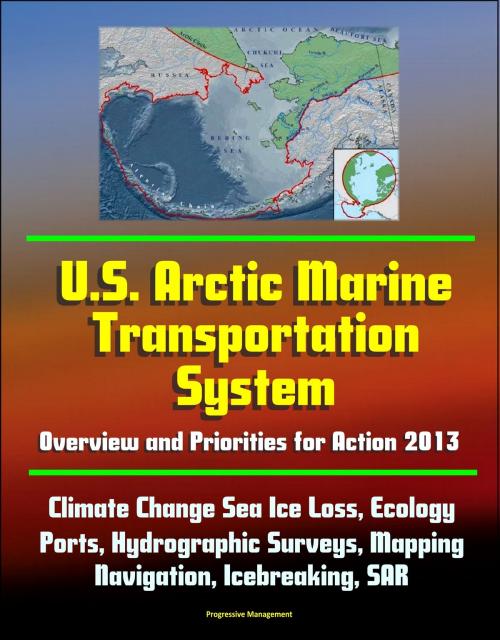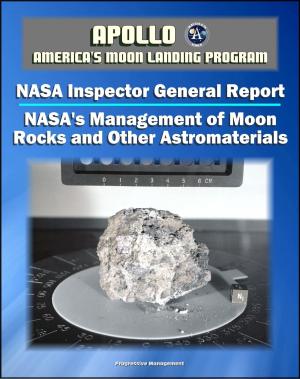U.S. Arctic Marine Transportation System: Overview and Priorities for Action 2013 - Climate Change Sea Ice Loss, Ecology, Ports, Hydrographic Surveys, Mapping, Navigation, Icebreaking, SAR
Nonfiction, History, Polar Regions, Reference & Language, Transportation, Ships & Shipbuilding| Author: | Progressive Management | ISBN: | 9781310850820 |
| Publisher: | Progressive Management | Publication: | November 27, 2014 |
| Imprint: | Smashwords Edition | Language: | English |
| Author: | Progressive Management |
| ISBN: | 9781310850820 |
| Publisher: | Progressive Management |
| Publication: | November 27, 2014 |
| Imprint: | Smashwords Edition |
| Language: | English |
The Arctic is an intensely harsh operating environment, with extreme cold, heavy fog, severe storms, unpredictable ice flows and changing ice. These conditions persist even as sea ice has retreated 12 percent each decade since the 1970s. The combination of these elements creates a very challenging environment for those seeking to transit Arctic waters for any purpose.
Growth in human use of the Arctic illustrates the need, in both the short and longer term, for a more robust MTS infrastructure, whether for energy development, spill response, search and rescue, indigenous and environmental protections, or maritime law enforcement. For example, annual vessel traffic transiting the Bering Strait, the entry and exit point to the Western Arctic, increased from 220 vessels a year to 480 vessels a year, a more than 100 percent increase. The growth rate was particularly high for tank vessels; tugs and other cargo vessels were the second and third largest categories of movements. Moreover, Bering Strait transits from 2008 to 2012 rose from 220 to 480, again a more than 100 percent increase. In addition, the Economist reported in its June 2012 issue that Russia is escalating interest in its Northern Sea Route (NSR), which may cut transit time between Europe and Asia by a third. The article noted that, while four ships used the NSR in 2010, 34 ships transited in 2011. The expected increase in Arctic marine traffic volume has elevated this area as a strategic chokepoint and heightened the geostrategic importance of the Arctic for national, economic, and homeland security.
Another near-term example of an U.S. Arctic marine transportation driver has been the 2012 exploratory oil drilling in the Beaufort and Chukchi Seas. A July 2012 Bloomberg government article reports that Royal Dutch Shell PLC has spent $4.5 billion on Arctic drilling preparations since 2005. This and other indicators of private sector intent to expand exploration in the region, both within and beyond U.S. waters, highlights the potential for economic opportunity in the Arctic, while underscoring the need for emergency preparedness.
In addition, the United States is acquiring Arctic bathymetric and seafloor data to support delineation of the U.S. Extended Continental Shelf (ECS) in the Arctic outer limit (i.e., its continental shelf beyond 200 nautical miles from shore). This includes the seabed resources therein pursuant to the Law of the Sea Convention (LOSC). The likelihood of increased resource extraction in the U.S. Arctic presents a variety of commercial, environmental, and security challenges and concerns. U.S. interest in Arctic ECS (and elsewhere) further underscores the need for the United States to become a party to LOSC to fully secure such rights.
Executive Summary * Chapter 1: The Case for a U.S. Arctic Marine Transportation System (MTS) * Policy and Purpose * Loss of Sea Ice, Change Driving Change * Examples of Increased Use of Marine Transportation in the Arctic * Implications of Increased Arctic Marine Transportation * Chapter 2: Current State of the U.S. Arctic Marine Transportation System * Chapter 3: The U.S. Arctic MTS in Depth - Issue Papers * Places of Refuge for Ships * Areas of Heightened Ecological Significance * Ports and Associated Facilities * Geospatial Infrastructure * Hydrographic Surveys * Shoreline Mapping * Aids to Navigation * Communications * Marine Weather and Sea Ice Forecasts * Oceanographic and Real-Time Navigation Information * Automatic Identification System * Vessel Escort and Icebreaking * Environmental Response Management * Search and Rescue/Emergency Response * Polar Code/Guidelines for Ships Operating in Arctic Ice-Covered Waters * Crew Standards/Training * Chapter 4: A U.S. Arctic MTS - The Way Ahead * Recommendations * Rely on CMTS for U.S. Arctic MTS Coordination * Join the Law of the Sea Convention * Implement U.S. Arctic MTS Improvement Plan - Priorities, Timeframes * A U.S. Arctic Strategy and Partnerships
The Arctic is an intensely harsh operating environment, with extreme cold, heavy fog, severe storms, unpredictable ice flows and changing ice. These conditions persist even as sea ice has retreated 12 percent each decade since the 1970s. The combination of these elements creates a very challenging environment for those seeking to transit Arctic waters for any purpose.
Growth in human use of the Arctic illustrates the need, in both the short and longer term, for a more robust MTS infrastructure, whether for energy development, spill response, search and rescue, indigenous and environmental protections, or maritime law enforcement. For example, annual vessel traffic transiting the Bering Strait, the entry and exit point to the Western Arctic, increased from 220 vessels a year to 480 vessels a year, a more than 100 percent increase. The growth rate was particularly high for tank vessels; tugs and other cargo vessels were the second and third largest categories of movements. Moreover, Bering Strait transits from 2008 to 2012 rose from 220 to 480, again a more than 100 percent increase. In addition, the Economist reported in its June 2012 issue that Russia is escalating interest in its Northern Sea Route (NSR), which may cut transit time between Europe and Asia by a third. The article noted that, while four ships used the NSR in 2010, 34 ships transited in 2011. The expected increase in Arctic marine traffic volume has elevated this area as a strategic chokepoint and heightened the geostrategic importance of the Arctic for national, economic, and homeland security.
Another near-term example of an U.S. Arctic marine transportation driver has been the 2012 exploratory oil drilling in the Beaufort and Chukchi Seas. A July 2012 Bloomberg government article reports that Royal Dutch Shell PLC has spent $4.5 billion on Arctic drilling preparations since 2005. This and other indicators of private sector intent to expand exploration in the region, both within and beyond U.S. waters, highlights the potential for economic opportunity in the Arctic, while underscoring the need for emergency preparedness.
In addition, the United States is acquiring Arctic bathymetric and seafloor data to support delineation of the U.S. Extended Continental Shelf (ECS) in the Arctic outer limit (i.e., its continental shelf beyond 200 nautical miles from shore). This includes the seabed resources therein pursuant to the Law of the Sea Convention (LOSC). The likelihood of increased resource extraction in the U.S. Arctic presents a variety of commercial, environmental, and security challenges and concerns. U.S. interest in Arctic ECS (and elsewhere) further underscores the need for the United States to become a party to LOSC to fully secure such rights.
Executive Summary * Chapter 1: The Case for a U.S. Arctic Marine Transportation System (MTS) * Policy and Purpose * Loss of Sea Ice, Change Driving Change * Examples of Increased Use of Marine Transportation in the Arctic * Implications of Increased Arctic Marine Transportation * Chapter 2: Current State of the U.S. Arctic Marine Transportation System * Chapter 3: The U.S. Arctic MTS in Depth - Issue Papers * Places of Refuge for Ships * Areas of Heightened Ecological Significance * Ports and Associated Facilities * Geospatial Infrastructure * Hydrographic Surveys * Shoreline Mapping * Aids to Navigation * Communications * Marine Weather and Sea Ice Forecasts * Oceanographic and Real-Time Navigation Information * Automatic Identification System * Vessel Escort and Icebreaking * Environmental Response Management * Search and Rescue/Emergency Response * Polar Code/Guidelines for Ships Operating in Arctic Ice-Covered Waters * Crew Standards/Training * Chapter 4: A U.S. Arctic MTS - The Way Ahead * Recommendations * Rely on CMTS for U.S. Arctic MTS Coordination * Join the Law of the Sea Convention * Implement U.S. Arctic MTS Improvement Plan - Priorities, Timeframes * A U.S. Arctic Strategy and Partnerships















